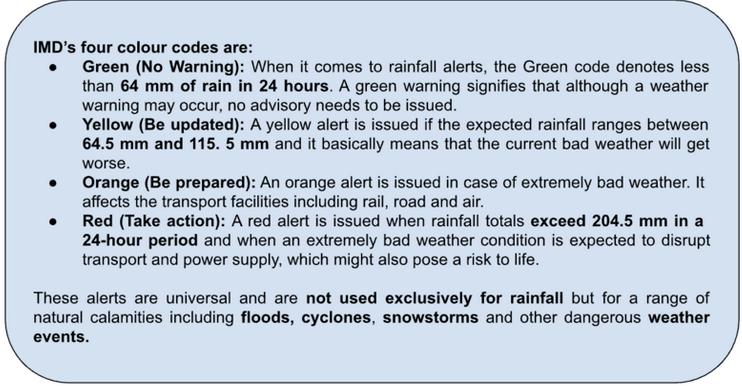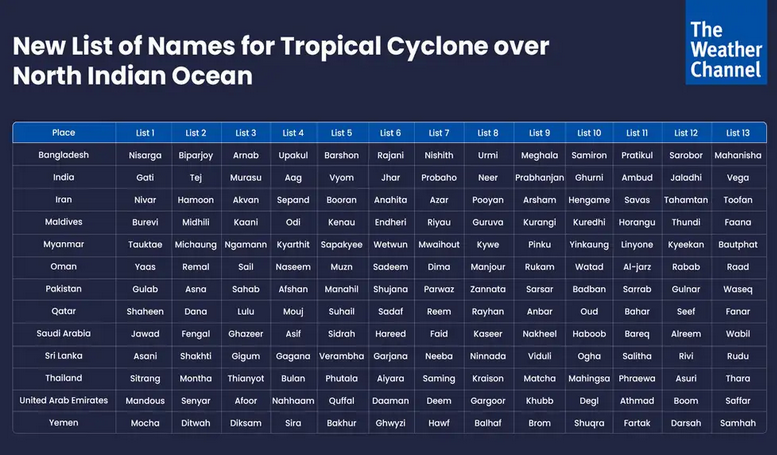News Excerpt:
Cyclone Remal made landfall on the night of 26th May on the coasts of West Bengal and Bangladesh as a severe Cyclonic Storm, bringing heavy rain and gusty winds.
About Cyclone Remal:
- The name Remal, meaning ‘sand’ in Arabic, was chosen from Oman. It is the first cyclone in the Bay of Bengal this pre-monsoon season.
- The cyclone's formation was initiated by a low-pressure over the southwest and west-central Bay of Bengal, which has since intensified into Cyclone Remal.

Cyclone Strength and Impact:
- Cyclone Remal wreaked havoc across the state of West Bengal and neighbouring Bangladesh, with wind speeds reaching up to 135 km per hour.
- The India Meteorological Department (IMD) informed that severe cyclonic storm Remal has weakened into a cyclonic storm in the early hours of Monday, and is expected to gradually weaken further.
- Its centre is located 90 km away from Kolkata in the east direction. It is now progressing towards Assam and Meghalaya.
- The cyclone is likely to impact the Sundarbans mangrove forest, one of the largest in the world, renowned for its diverse fauna.
Scientific Insights:
- Scientists say cyclonic storms are intensifying rapidly and retaining their potency for longer periods due to warmer sea surface temperatures, a result of oceans absorbing most of the excess heat from greenhouse gas emissions.
- According to a senior IMD scientist, warmer sea surface temperatures mean more moisture, which is favourable for the intensification of cyclones.
|
Tropical cyclones:
 |
How are the cyclones named?
- The World Meteorological Organisation (WMO) is a 185-member United Nations agency.
- Realising the importance of an effective cyclone warning and disaster mitigation in the North Indian Ocean region (comprising both the Arabian Sea and the Bay of Bengal), WMO came together in 1972 to establish the Panel on Tropical Cyclones (PTC).
- The PTC originally comprised eight member countries — Bangladesh, India, Maldives, Myanmar, Pakistan, Sri Lanka, Sultanate of Oman and Thailand.
- The PTC then began naming tropical cyclones in the Bay of Bengal and Arabian Sea in 2004, after receiving recommendations from panel countries.
- In 2018, the PTC expanded to include Iran, Qatar, Saudi Arabia, the UAE, and Yemen.
- In April 2020, a list of 169 cyclone names was released — 13 suggestions each from the 13 countries. It is this list that is currently being used to name cyclones.
How the naming convention works:
- There are some basic guidelines that countries need to follow while sending in their proposals. These include ensuring that the proposed name is neutral to
(a) politics and political figures
(b) religious beliefs,
(c) cultures and
(d) gender;
-
- does not hurt the sentiments of any group of population over the globe;
- is not very rude and cruel in nature;
- is short, easy to pronounce, and not offensive to any PTC member;
- is at most eight letters long;
- is not repeated (not before, not after).
- The list of proposed names arranges the countries in alphabetical order and lists all the names suggested by them.
- Then these names are allotted to any cyclone, which takes place in the region, on a rotational basis regardless of which country proposed it.
- For instance, the first cyclone after the list was named Nisarga (Bangladesh’s name choice), which hit Maharashtra, followed by Gati (India’s choice, hit Somalia), Nivar (Iran’s choice, hit Tamil Nadu), and so on.
Why name cyclones at all?
- Adopting names for cyclones makes it easier for people to remember, as opposed to numbers and technical terms.
- Apart from the general public, it also helps the scientific community, the media, disaster managers etc.
- With a name, it is easy to identify individual cyclones, create awareness of its development, rapidly disseminate warnings to increase community preparedness and remove confusion where there are multiple cyclonic systems over a region.



